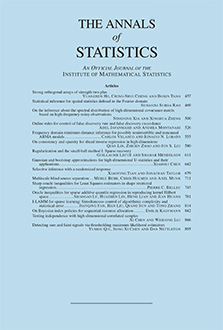Abstract
We study the fundamental limits of detecting the presence of an additive rank-one perturbation, or spike, to a Wigner matrix. When the spike comes from a prior that is i.i.d. across coordinates, we prove that the log-likelihood ratio of the spiked model against the nonspiked one is asymptotically normal below a certain reconstruction threshold which is not necessarily of a “spectral” nature, and that it is degenerate above. This establishes the maximal region of contiguity between the planted and null models. It is known that this threshold also marks a phase transition for estimating the spike: the latter task is possible above the threshold and impossible below. Therefore, both estimation and detection undergo the same transition in this random matrix model. Further information on the performance of the optimal test is also provided. Our proofs are based on Gaussian interpolation methods and a rigorous incarnation of the cavity method, as devised by Guerra and Talagrand in their study of the Sherrington–Kirkpatrick spin-glass model.
Citation
Ahmed El Alaoui. Florent Krzakala. Michael Jordan. "Fundamental limits of detection in the spiked Wigner model." Ann. Statist. 48 (2) 863 - 885, April 2020. https://doi.org/10.1214/19-AOS1826
Information





